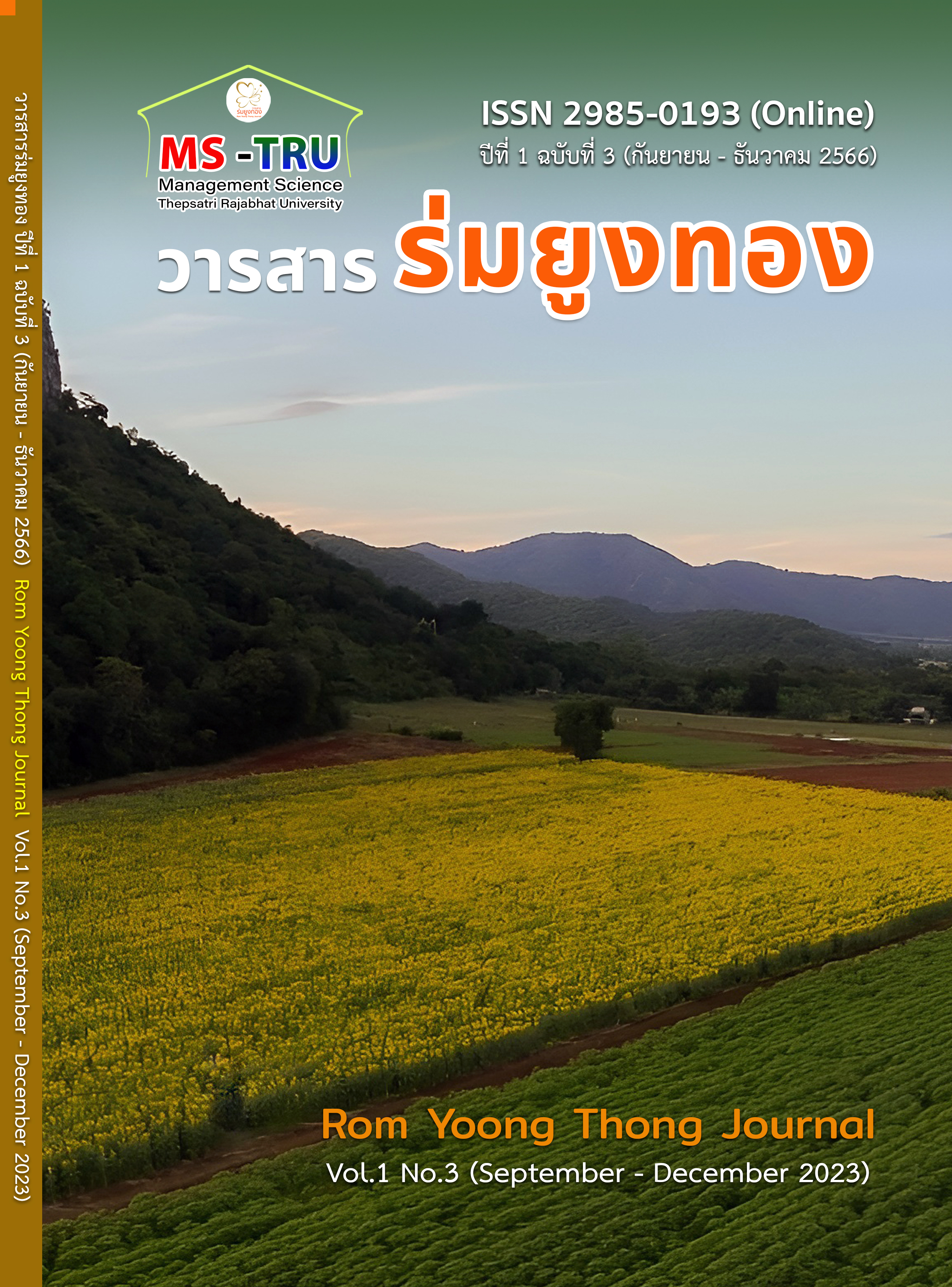Development on Community-based Tourism Activity of Ban Madue Chumphon Kosamphi Nakhon District, Kamphaeng Phet Province.
Keywords:
development, tourism activity, community-based tourismAbstract
This research aimed to achieve three objectives: 1) to survey the tourism context of the Ban Madeua community, Chumphon District, Kosamphi Nakhon District, Kamphaeng Phet Province, 2) to disseminate marketing communication innovations for the development of community-based tourism in Ban Madeua, Chumphon District, Kosamphi Nakhon District, Kamphaeng Phet Province and 3) to develop tourism activities within in the community of Ban Madeua, Chumphon District, Kosamphi Nakhon District, Kamphaeng Phet Province. The research tools consisted of in-depth interviews and focus group discussions with 16 key informants. The data analysis was conducted utilizing content analysis.
The research findings revealed that the community of Ban Madeua, Chumphon was situated along the Ping River and possesses various tourism resources within the community. These included the Madaeu community market at Wat Madaeu, Ping River boat tours, Thai dessert-making classes, health spas offering traditional Thai massages, Luang Pu Haad Wat Madaeu Chumphon, Wat Ko Tam Yea, the Sua God Shrine, mango orchards in the community in the community, as well as resorts and riverside dining establishments along the Ping River. Following the dissemination of marketing communication innovations for the development of community tourism, it became evident how important it is to transfer innovations from local areas to foster sustainable community-based tourism activities in Ban Madeua, Chumphon community. Moreover, the community-based tourism activities in Ban Madeua aligned with the local culture, history, and environment. These activities included pilgrimage tourism, rubber ring rafting, Thai dessert-making classes, and health promotion activities.
References
กระทรวงการท่องเที่ยวและกีฬา. (2565). สถานการณ์การท่องเที่ยวในประเทศ รายจังหวัด ปี 2565. Retrieved from https://www.mots.go.th/news/category/657
กระทรวงการอุดมศึกษา วิทยาศาสตร์ วิจัยและนวัตกรรม. (2564). (ร่าง) ยุทธศาสตร์ การขับเคลื่อนการพัฒนาประเทศไทยด้วยเศรษฐกิจ BCG พ.ศ. 2564 - 2569 วิจัยและนวัตกรรม. กรุงเทพฯ: กระทรวงการอุดมศึกษา วิทยาศาสตร์ วิจัยและนวัตกรรม.
กระทรวงวัฒนธรรม. (2560). ท่องเที่ยวชุมชนบนเส้นทางเรียนรู้. วารสารวัฒนธรรม, 56(4), 6-21.
คณะกรรมการนโยบายการท่องเที่ยวแห่งชาติ. (2566). แผนพัฒนาการท่องเที่ยวแห่งชาติ ฉบับที่ 3 (พ.ศ.2566-2570). กรุงเทพฯ: กองยุทธศาสตร์และแผนงาน สำนักงานปลัดกระทรวงการท่องเที่ยวและกีฬา.
จังหวัดกำแพงเพชร. (2564). แผนพัฒนาจังหวัดกำแพงเพชร พ.ศ. ๒๕๖๖ - ๒๕๗๐. กำแพงเพชร: จังหวัดกำแพงเพชร.
ประชาคมวิจัยด้านเศรษฐกิจชีวภาพ เศรษฐกิจหมุนเวียน และเศรษฐกิจสีเขียว. (2561). สมุดปกขาว BCG in Action การพัฒนาวิทยาศาสตร์ เทคโนโลยีและนวัตกรรมของประเทศไทย เพื่อเศรษฐกิจชีวภาพ เศรษฐกิจหมุนเวียน และเศรษฐกิจสีเขียว. Retrieved from https://www.nstda.or.th/home/knowledge_post/bcg-in-action/
พรพจน์ ศรีดัน. (2564). รายงานฉบับสมบูรณ์โครงการนวัตกรรมทางสังคมกลุ่มวิสาหกิจชุมชนเพื่อการพัฒนาผลิตภัณฑ์สู่การแข่งขันเชิงพาณิชย์ภายใต้แนวคิดเศรษฐกิจหมุนเวียน (Circular Economy). Retrieved from http://www.cusri.chula.ac.th/wp-content/uploads/2022/12รายงานฉบับสมบูรณ์โครงการนวัตกรรมทางสังคม.pdf
รัตติยา เหนืออำนาจ พระเทพปริยัติเมธี และนัยนา เกิดวิชัย. (2562). การพัฒนาตัวแบบการจัดการท่องเที่ยวโดยชุมชนเชิงสร้างสรรค์ในจังหวัดนครสวรรค์. วารสารมหาจุฬาวิชาการ, 7(1), 72-88.
สรรเสริญ วงศ์ชะอุ่ม. (2554). การวางแผนพัฒนาประเทศ. นนทบุรี: บริษัท ศูนย์การพิมพ์เพชรรุ่ง จำกัด.
สำนักงานปลัดกระทรวงการท่องเที่ยวและกีฬา. (2563). รายงานภาวะเศรษฐกิจการท่องเที่ยว. Retrieved from https://www.mots.go.th/more_news_new.php?cid=581
สำนักงานพัฒนาวิทยาศาสตร์และเทคโนโลยีแห่งชาติ (สวทช.). (2566). BCG เป็นมาอย่างไร. Retrieved from https://www.bcg.in.th/background/
สุขุม คงดิษฐ์ วรรษา พรหมศิลป์ ธนรัตน์ รัตนพงศ์ธระ จิดาภา เร่งมีศรีสุข และ ธารณี นวัสนธี. (2560). รูปแบบและกิจกรรมที่เหมาะสมกับการท่องเที่ยวเชิงนิเวศเกษตรอย่างมีส่วนร่วมของชุมชนสามเรือน
จังหวัดพระนครศรีอยุธยา. วารสารวิจัยเพื่อการพัฒนาเชิงพื้นที่, 9(4), 314-326.
สุพัตรา ราษฎร์ศิริ. (2562). การพัฒนาชุมชนอย่างยั่งยืน:กรณีศึกษา บ้านรักไทย แม่ฮ่องสอน.
มหาวิทยาลัยรังสิต.
สุภางค์ จันทวานิช. (2548). วิธีการวิจัยเชิงคุณภาพ (พิมพ์ครั้งที่ 13). กรุงเทพฯ : จุฬาลงกรณ์มหาวิทยาลัย.
สุภาภรณ์ ประสงค์ทัน. (2556). ทุนทางสังคมกับแนวทางการส่งเสริมการท่องเที่ยวโดยชุมชนเชิงสร้างสรรค์: กรณีศึกษาชาวไทยพวน อ.ปากพลี จ.นครนายก. วารสารสังคมศาสตร์ มหาวิทยาลัยศรีนครินทรวิโรฒ, 16(1), 225-235.
โอปอล์ รังสิมันตุชาติ และทิพาพร โพธิ์ศรี. (2564). การพัฒนากิจกรรมท่องเที่ยวเชิงวัฒนธรรมโดยการมีส่วนร่วมของชุมชนท้องถิ่นคอรุม จังหวัดอุตรดิตถ์. Journal of Modern Learning Development, 6(3), 355-369.
González-Morcillo, S., Horrach-Rosselló, P., Valero-Sierra, O., & Mulet-Forteza, C. (2022). Forgotten effects of active tourism activities in Spain on sustainable development dimensions. Environment, Development and Sustainability. doi:10.1007/s10668-022- 02503-3
Ohridska-Olson, R. V., & Ivanov, S. (2010). Creative Tourism Business Model and its Application in Bulgaria. Institutions & Transition Economics: Microeconomic Issues eJournal.
Richards, G. (2017). Creative tourism: opportunities for smaller places? Tourism & Management Studies, 15. doi:10.18089/tms.2019.15SI01
Sinha, P. C. (1997). International encyclopaedia of tourism management (Vol. 12). New Delhi Anmol Publications
Downloads
Published
How to Cite
Issue
Section
License
Copyright (c) 2023 คณะวิทยาการจัดการ มหาวิทยาลัยราชภัฏเทพสตรี

This work is licensed under a Creative Commons Attribution-NonCommercial-NoDerivatives 4.0 International License.





